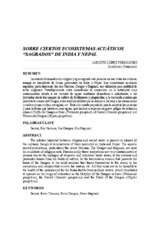Mostrar el registro sencillo del ítem
Sobre ciertos ecosistemas acuáticos “sagrados” de India y Nepal
| dc.contributor.author | López Fernández, Aniceto | |
| dc.date.accessioned | 2016-04-19T12:26:45Z | |
| dc.date.available | 2016-04-19T12:26:45Z | |
| dc.date.issued | 2012 | |
| dc.identifier.uri | http://hdl.handle.net/10396/13432 | |
| dc.description.abstract | La relación binomial entre religión y agua sagrada está presente en casi todas las culturas, aunque se manifiesta de forma potenciada en India y Nepal. Los ecosistemas acuáticos sagrados, particularmente los ríos Yamuna, Ganges y Bagmati, son utilizados para multitud de actos religiosos. Paradójicamente estos ecosistemas se encuentran en la actualidad muy contaminados debido a los vertidos de aguas residuales domésticas e industriales, a los lixiviados desde los campos de cultivo de fertilizantes y plaguicidas, a la tremenda erosión que presenta la cuenca del Ganges, a los residuos sólidos que se arrojan a los ríos, a las cremaciones y cadáveres que reciben sus aguas, etc. Todo ello resulta perjudicial para la salud de las personas y para la fauna que habita en esas aguas, que incluye a especies en grave peligro de extinción como el Delfín del Ganges o Susu (Platanista gangetica), el Gavial (Gavialis gangeticus) y el Tiburón del Ganges (Glyphis gangeticus). | es_ES |
| dc.description.abstract | The relation binomial between religion and sacred water is present in almost all the cultures, though it demonstrates of form promoted in India and Nepal. The aquatic sacred ecosystems, particularly the rivers Yamuna, The Ganges and Bagmati, are used for multitude of religious acts. Paradoxically these ecosystems are very contaminated at present due to the spillages of domestic and industrial waste water, to the nutrient and pesticides losses from the fields of culture, to the tremendous erosion that presents the basin of the Ganges, to the solid residues that throw themselves to the rivers, to the cremations and corpses that receive his waters, etc. All this turns out to be harmful to the health of the persons and for the fauna that he lives in these waters, which it includes to species on the verge of extinction as the Dolphin of the Ganges or Susu (Platanista gangetica), the Gavial (Gavialis gangeticus) and the Shark of the Ganges (Glyphis gangeticus). | es_ES |
| dc.format.mimetype | application/pdf | es_ES |
| dc.language.iso | spa | es_ES |
| dc.publisher | Real Academia de Córdoba de Ciencias, Bellas Letras y Nobles Artes | es_ES |
| dc.rights | https://creativecommons.org/licenses/by-nc-nd/4.0/ | es_ES |
| dc.source | Boletín de la Real Academia de Córdoba de Ciencias, Bellas Letras y Nobles Artes 161, 366-379 (2012) | es_ES |
| dc.subject | Baoris | es_ES |
| dc.subject | Río Yamuna | es_ES |
| dc.subject | Río Ganges | es_ES |
| dc.subject | Río Bagmati | es_ES |
| dc.subject | Baoris | es_ES |
| dc.subject | River Yamuna | es_ES |
| dc.subject | River Ganges | es_ES |
| dc.subject | River Bagmati | es_ES |
| dc.title | Sobre ciertos ecosistemas acuáticos “sagrados” de India y Nepal | es_ES |
| dc.type | info:eu-repo/semantics/article | es_ES |
| dc.rights.accessRights | info:eu-repo/semantics/openAccess | es_ES |

